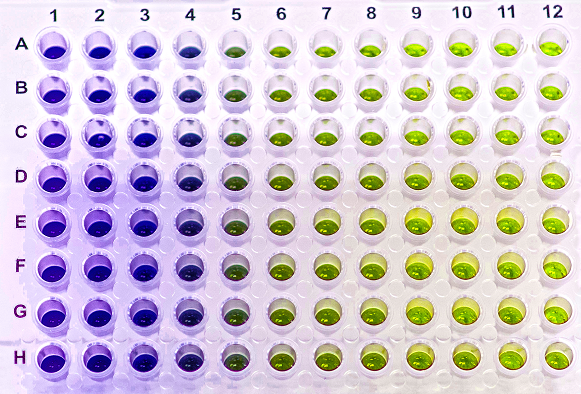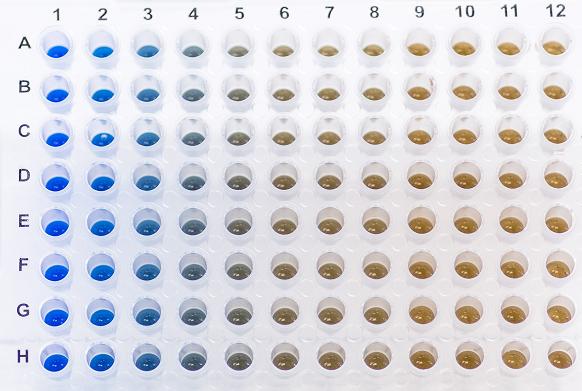
When it comes to immunological analysis, you can’t forget enzyme-linked immunosorbent assays, commonly referred to as ELISAs. This process was developed to determine the presence of antibodies in a biological sample. Samples processed may be protein mixtures from a cellular lysis or sourced from an organism being studied for infection. Data can be quantified for antigen concentration; alternatively, results are qualified for a positive or negative diagnosis.
The method isn’t as simple as tossing a solution into the assay and getting a “yes” or “no.” Immunodiagnostics are a bit more complicated than that, and some assessments can’t be accomplished with the simplest ELISA format. To compensate for these circumstances, multiple ELISA procedures have been developed. Here, we’ll differentiate the four primary categories by process, advantages and disadvantages. We’ll ascend through the list based on the process’s simplicity.
|
|
||
Direct ELISA
The most straightforward version of these assays is the direct ELISA, a test capable of identifying antigens in a sample by optimizing the formation of antigen-antibody complexes.
Stages
- A prepared, usually diluted sample containing the antigen is incubated, promoting antigen molecules to attach against the walls of a solid-phase well plate; excess solution is rinsed away
- Protein additive (usually BSA) is applied to the plate to block other binding sites the antigen hasn’t covered, and the plate is washed again
- Antigen-specific antibody is applied and interacts with the antigens, surplus antibodies are removed by a third wash that leaves only active antigen-antibody complexes in the well
- The antibodies carry enzymes for identification, so enzyme substrate is added to activate with the conjugated enzymes, and the plate undergoes a final wash
- The enzyme reaction is measured and demonstrates antigen presence with either a colored or fluorescent signal; higher concentrations of antibody in the solution produce stronger signals
- The signal is quantified by a spectrometer
Advantages
Direct assays are the simplest ELISA and offer the fastest performance. It is capable of providing data on antibody-to-antigen reactions by detecting the specific antigens in a sample. Even if there are few bound antibodies, the enzymes attached to these complexes will produce multiple signal molecules and trigger detection. This technique eliminates the potential for cross-reactivity because only one antibody is used.
Disadvantages
The direct analysis produces lower sensitivity results. And there is potential for a higher background than other ELISA methods. Therefore, it’s necessary to purify your sample. In addition, enzyme-conjugated primary antibodies are uncommon and labeling them yourself is a time-consuming and expensive process.
|
|
||
Indirect ELISA
The indirect method is similar to direct in that sample antigen and blocking protein solutions are attached to the solid phase wells, requiring the same wash cycles and detection mechanism. The main difference exists in the antibodies: indirect ELISA primary antibody is not labeled by an enzyme when it forms its complex. Following the first three steps of the direct ELISA method, we then add the following stages.
Stages
- An enzyme-conjugated secondary antibody is applied to react with the attached primary antibody forming complexes with the sample antigens
- The secondary antibody’s enzyme substrate is then added to detect the secondary antibody and thus the antigen two molecular layers away
Advantages
Indirect methods raise sensitivity because multiple antibodies attach to each antigen and their concentration is measured. Specific antibodies are detected with fewer labeled antibodies, and primary antibodies are optimally reactive to the sample antigen because they’re unlabeled. Additionally, multiple primary antibodies can be recognized by one species of secondary antibody, and there are a multitude of secondary antibodies available, making this technique versatile.
Disadvantages
As in direct ELISA, small samples of antigen can be missed in detection if nonspecific binding occurs on the wells, so purification is often necessary. Cross-reactivity among secondary antibodies can result in nonspecific signals. The process involves more stages; if you don’t want to add extra steps to the original form, secondary antibodies may be an inconvenience.
|
|
||
Sandwich ELISA
Slightly altered from the first two tests, the sandwich ELISA method measures the quantity of an antigen caught between two different antibody layers. This requires a pair of molecules, one species for “capture” and the other for “detection.” Both need to be optimally reactive with the antigen of interest.
Stages
- A “capture” antibody is incubated and attached to the solid phase plate that is then washed
- Non-specific protein is added to fill open sites
- Sample solution with an unknown antigen (displaying at least two epitopes) is applied and captured by well-bound antibody, forming a complex
- Antigen-specific “detection” antibody is then added and attaches to another open epitope of the antigen
- If the detection antibody has been enzyme-conjugated, its enzyme is triggered by substrate
- There’s an additional step if another enzyme-linked secondary antibody is employed to detect the detection antibodies, totaling three antibody species; these are then detected with an enzyme substrate for measurement
Advantages
Samples in sandwich ELISA don’t need to be purified as with direct and indirect versions because of the specificity involved, so this method is good for complex samples. Heightened sensitivity results from capture activity; sample antigen is detected efficiently at low or unknown concentrations. There is also the option of using either direct or indirect antibody relationships for final signal production.
Disadvantages
Sandwich ELISA is overall difficult to optimize. The antigen being studied must display multiple epitopes for the two antibodies to react. The two (or three) antibodies involved can’t disrupt each other’s antigen complexes, so they must be “match-paired” to avoid this. “Match-paired” antibodies must be monoclonal to recognize specific epitopes. It’s difficult to find detection antibodies that are conjugated, leading to the necessity of three antibodies. On top of these complications, you add even more steps to the assay process than were involved in the first two options.
|
|
||
Competitive ELISA
Competitive ELISAs are the most separated in comparison to the alternate assays. This division is due to the competitive binding necessary within the solution being analyzed. Data is also assessed in the opposite way to all previous ELISAs.
Stages
- An unlabeled primary antibody and sample antigen are incubated together
- The resulting complex is applied to a plate with the same antigen coated on the wells
- Any primary antibodies without previous complex-binding formed during incubation will attach to the plated antigen while complexes are washed away
- Enzyme-conjugated secondary antibody binds to the newly bound primary antibodies, and enzyme substrate is added for signal production; weaker final signals imply a higher concentration of antigen in the original sample
- Other kits use labeled antigen which binds to any primary antibody not in a complex with the sample antigen, and this concentration is measured as plate-bound antibodies would be
Advantages
Competing antibodies or proteins produce highly specific results in this method. Impure samples will maintain selectivity, and specific capture is helpful for detection. As with sandwich ELISA, direct and indirect processes can be used, but there is no need for match-pairing in competitive ELISA. Furthermore, there is the option of primary antibody being monoclonal or polyclonal.
Disadvantages
Competitive ELISA operates on a different system than the previous examples, so you have to change your perspective on the operation and interpret results accordingly. The antigen of interest must also display only one epitope detectable by the primary antibody for results to be accurate.
|
|
||
ELISA is a versatile technique with different options to fit various laboratory analyses. Each version of the assay has different stages, benefits and drawbacks associated to it, so the informed researcher should consider these before making a decision. Choose the appropriate ELISA based on the sample you test and results you need; this will produce the most reliable, relevant data. Browse some of GoldBio's antibody labeling and protein purification products to begin your next research project.

|
|
||
References
Davis, C. P. (n.d.). ELISA Tests. Retrieved August 3, 2017, from http://www.medicinenet.com.
Giri, D. (2015, December 24). ELISA : Principle, Procedure, Types, Applications and Animation. Retrieved August 4, 2017, from http://laboratoryinfo.com/elisa.
 Megan Hardie GoldBio Staff Writer |
Megan Hardie is an undergraduate student at The Ohio State University’s Honors Arts and Sciences program. Her eclectic interests have led to a rather unwieldly degree title: BS in Anthropological Sciences and BA English Creative Writing, Forensics Minor. She aspires to a PhD in Forensic Anthropology and MA in English. In her career, she endeavors to apply the qualities of literature to the scientific mode and vice versa, integrating analysis with artistic expression. |
Category Code: 79104, 79107, 79108





